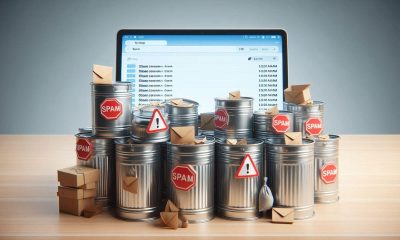We all know about WinRAR as one of the best compression utility.
Easier to use, Clean interface, Good Compression rate… but most of us still don’t know about its Special Feature of making [SFX] Self-Extracting Archives ( setup or .exe File).
Taken from the help file of WinRAR:
An SFX (SelF-eXtracting) archive is an archive, merged with an executable module, which is used to extract files from the archive when executed. Thus no external program is necessary to extract the contents of an SFX archive, it is enough to execute it. Nevertheless WinRAR can work with SFX archives as with any other archives, so if you do not want to run a received SFX archive (for example, because of possible viruses), you may use WinRAR to view or extract its contents.
SFX archives usually have .exe extension as any other executable file.
SFX archives are convenient if you want to give an archive to somebody, but do not know, if they have an appropriate archiver to extract files from it. You may also use SFX archives to distribute your own software.
So here we go…
Here I am making an SFX of some flash games.
First Open WinRAR.
Browse to folder where your files are placed of which you want to make SFX.
You can also simply right click the folder, and click “Add to Archive”.
Remember if you are making a SFX, best practice is to put all your files in a folder first, and then make the SFX of that folder. Don’t try to add to add the files directly to SFX.
So, I’m going up one folder, and adding that folder into archive.
Now From Command Menu, Select> “Add Files to Archive” or Press “Ctrl+A”.
A New Window appears;
Here you have to tick the Checkbox “Create SFX Archive”
You’ll notice that Archive name will change from “Games.rar “to “Games.exe”.
Choose “Best” from Compression Method Combo box to assure maximum compression.
For Advance Options, Go to “Advance” tab.
(If you set the password, you can set it by clicking “Set password” button.)
Now, click “SFX options” button.
On the “Advance SFX Options” Window, You’ll find these tabs.
Each of them is explained one by one.
>>Path to extract
Set the default destination path for unpacked files.
This option allows SFX to store the destination path entered by user to Registry and then restore it when SFX archive with the same Path to extract contents executed the next time. The original path value is placed to the list associated with the destination path input field, so a user may choose between previously entered and original paths.
This feature may be convenient when installing new versions or upgrades of some software in the same folder. It allows to change the proposed path to desired only once instead of retyping it every time.
Or you may choose to create it in the user’s “Program Files” folder, in the current folder or specify an absolute path here.
Setup program/Run after extraction
SFX will try to execute the specified program (here) after successful extraction.
>>Save current settings as default
Save settings entered in all sections of “Advanced SFX options” dialog including the current section and use them later as default every time when creating a self-extracting archive.
>>Files to delete in the destination folder
SFX will try to delete the specified file or files in the destination folder before extraction. You may enter more than one file here; in this case file names have to be separated with spaces.
If a file specified here is locked and cannot be deleted, SFX module will try to rename it to temporary name before extraction and delete after Windows reboot. Success of this operation depends on Windows version.
>>Shortcuts Allows creating shortcuts to archived files after unpacking. Press “Add shortcut” button to describe a new shortcut.
>>Request administrative access
Set this option if you wish to create SFX archive, which will request the administrative access when started in Windows Vista only. This function does not work in older versions of Windows.
>>Temporary mode/Unpack to temporary folder
This option forces SFX to create a temporary folder, extract all files to it, start the program specified in Setup program/Run after extraction field and remove the temporary folder including all its contents after completing the Setup program. The SFX automatically sets the silent mode (described below) when performing these operations. If “Unpack to temporary folder” option is set, you should also specify Setup program and not use Path to extract field. You may also set two optional string parameters, which define a question and question title displayed before extraction. In such case extraction is started only if a user selects “Yes” button.
>>Silent mode
By default SFX asks for confirmation to start extraction and allows to user to change the destination folder. If you set “Silent mode” to “Hide start dialog” this confirmation will be skipped. Select “Hide all” if you also wish to hide whole extraction progress.
>>Overwrite mode
Here you may choose how SFX will handle already existing files: ask before overwrite (default), always overwrite or always skip.
>>Title of SFX window
Set the specified text as a title of the SFX window.
>>Text to display in SFX window
Add the specified plain text or HTML strings to the text output window of SFX module.
In case of plain text contents SFX module merges and reformats the specified text strings to fit them optimally into the dialog. So if you wish to start a new paragraph, you need to put the empty string before it.
Using HTML you may control colors, fonts and formatting of displayed text.
>>Load text from file
Load contents of selected file as SFX window text.
>>Load SFX logo from the file
Specify a bitmap image (*.bmp) file to display as logo in the created or updated SFX archive. Size of default SFX logo is 93×302 pixels. It is recommended to use bitmaps of same size or smaller.
>>Load SFX icon from the file
Replace the standard SFX icon by contained in the proposed .ico file. This file must include at least one 32×32 icon, 16 or 256 colors (or both).
>>Title of license window
Set the specified text as a title of the license window.
>>License text
Display the specified text as software license when starting SFX. User may either accept it and continue extraction or decline and quit.
License may be either in HTML or plain text format.
>>Load text from file
Load contents of selected file as license text.
The Next Tab “Module” is not that much important. Leave the default settings in there.
Click OK.
Other Tabs (marked in Red area) according to me are not that much important to create a SFX archive. They are just for additional options. So I’m not discussing those tabs. But if you want to explore them, you can. Settings changed in these tabs, will not effect the settings you have applied earlier, as I have already said they are just additional and optional.
After all these steps, simply Press “OK”.
….WinRAR will start archiving…
And After successful completion of above steps, you’ll have your SFX, an .exe file that you give to anybody, who can extract without installing any Archiving software not even WinRAR !!










